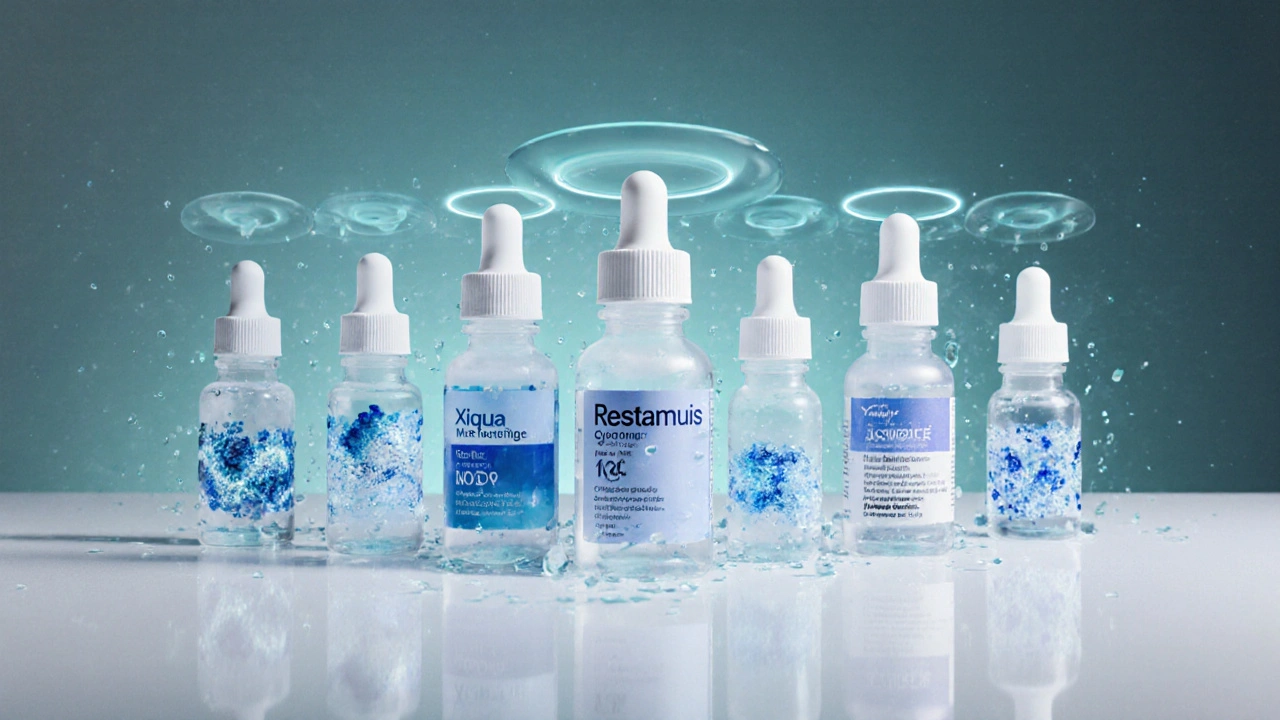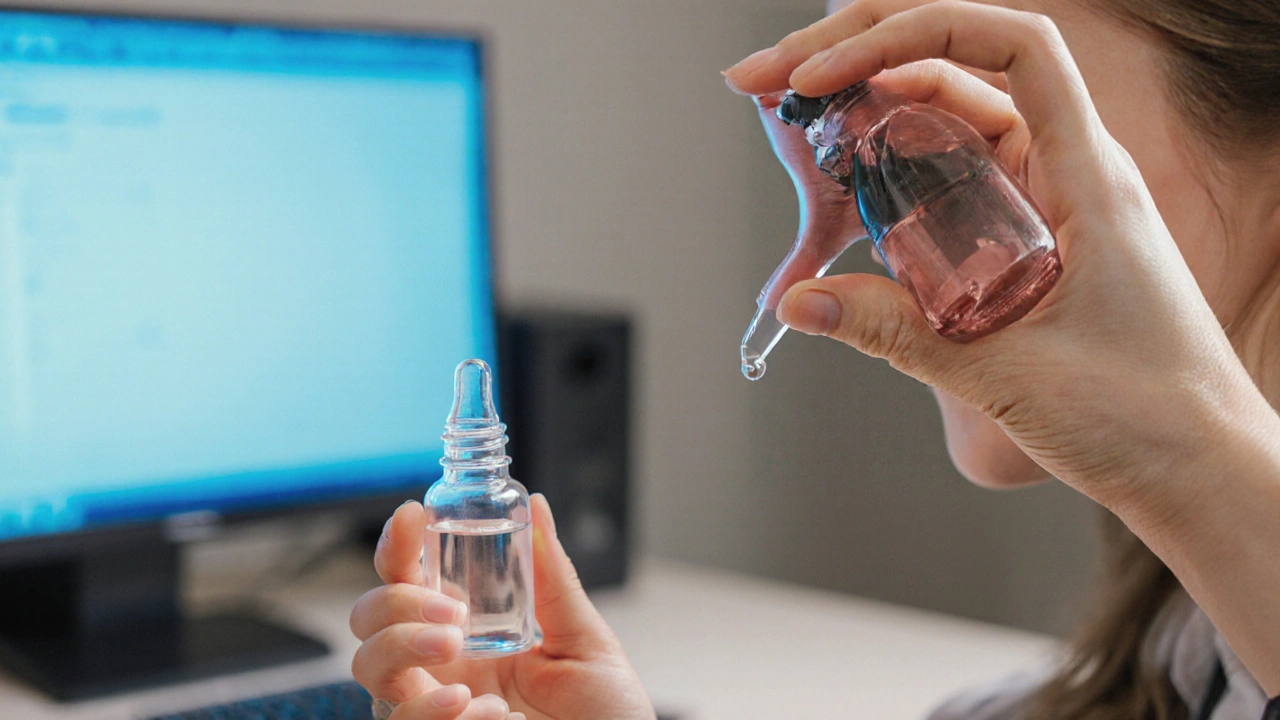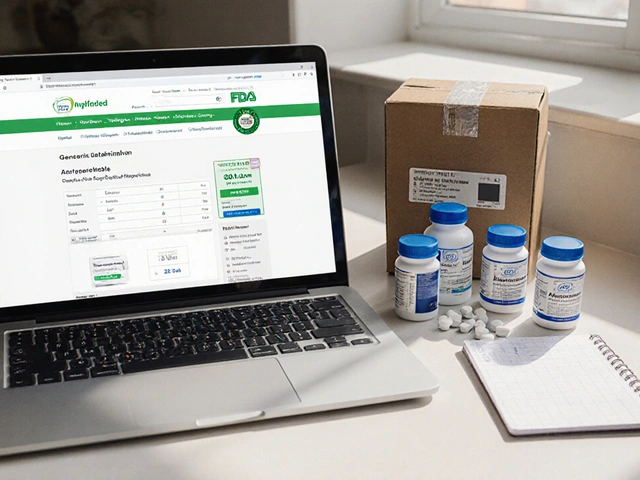Dry Eye Treatment Comparison Tool
Your Dry Eye Symptoms
Recommended Treatment
Select your symptoms and click "Find Best Treatment Match" to get personalized recommendations.
Treatment Overview
Cyclomune
Cyclosporine 0.05% - Prescribed for chronic inflammation
PBS EligibleCequa
Cyclosporine 0.09% - Higher dose, once daily
More ExpensiveXiidra
Lifitegrast 5% - Different mechanism, faster relief
No PBS CoverageRefresh PF
Polyethylene glycol + propylene glycol - Lubrication
OTC, Budget FriendlySystane Ultra
Polyethylene glycol + hydroxypropyl guar - Mucin mimic
OTC, Budget FriendlyRestasis
Cyclosporine 0.05% - Same as Cyclomune
No PBS CoverageEver wondered why some dry‑eye drops feel like a miracle while others barely make a difference? Cyclomune eye drops comparison will cut through the hype and show you exactly how Cyclomune stacks up against the most popular alternatives on the market today.
Quick Takeaways
- Cyclomune (cyclosporine) treats inflammation, not just lubrication.
- For fast relief, over‑the‑counter lubricants like RefreshPF are hard to beat.
- Xiidra works on a different inflammation pathway and may suit patients who don’t respond to cyclosporine.
- Cequa offers a higher concentration of cyclosporine with a more convenient dosing schedule.
- Cost and prescription requirements vary widely - plan ahead with your pharmacist.
What Is Cyclomune?
Cyclomune is a prescription eye drop that contains cyclosporine A, an immunomodulating agent that reduces ocular surface inflammation. Approved by the TGA in 2022, Cyclomune is designed for chronic dry‑eye disease (DED) where inflammation is the main driver. The typical regimen is one drop per eye twice daily, and most users notice improvement after four to six weeks.
Why Compare? The Real‑World Jobs You Want Done
When you search for a dry‑eye solution, you’re usually trying to achieve one of three things:
- Relieve burning, gritty sensations quickly.
- Address underlying inflammation for long‑term comfort.
- Find a cost‑effective option that fits your insurance or PBS status.
Each alternative we discuss targets at least one of those jobs. The table below maps them side‑by‑side.

Comparison Table: Key Attributes
| Product | Active Ingredient | Mechanism | Dosage Frequency | Prescription? | Typical Australian Cost (per month) |
|---|---|---|---|---|---|
| Cyclomune | Cyclosporine0.05% | Immunomodulation - reduces T‑cell‑mediated inflammation | Twice daily | Yes | ≈AU$120 (PBS subsidy may apply) |
| Restasis | Cyclosporine0.05% | Same as Cyclomune - T‑cell inhibition | Twice daily | Yes | ≈AU$130 (no PBS listing) |
| Cequa | Cyclosporine0.09% | Higher‑dose immunomodulation | Once daily | Yes | ≈AU$150 (often not PBS‑covered) |
| Xiidra | Lifitegrast5% | Blocks LFA‑1/ICAM‑1 interaction - reduces inflammatory cell adhesion | Twice daily | Yes | ≈AU$200 (no PBS subsidy) |
| RefreshPF | Polyethylene glycol 400+propylene glycol | Lubrication - restores tear film stability | As needed (usually 4‑6×/day) | No | ≈AU$30 (OTC) |
| SystaneUltra | Polyethylene glycol 400+propylene glycol+hydroxypropyl guar | Lubrication + mucin‑mimic to improve tear film | 2‑4×/day | No | ≈AU$40 (OTC) |
Deep Dive: How Each Option Works
Cyclomune tackles the root cause of many dry‑eye cases - chronic inflammation of the meibomian glands and ocular surface. By inhibiting calcineurin, it prevents T‑cell activation and reduces cytokine release. This results in a healthier tear‑producing environment, but the effect builds slowly.
Restasis is essentially the same formula that launched the cyclosporine class in the U.S. It shares the 0.05% concentration, so the efficacy and side‑effect profile are nearly identical to Cyclomune.
Cequa ups the dosage to 0.09%, which can produce a stronger anti‑inflammatory punch. Clinical trials showed a modest improvement in Schirmer scores after eight weeks, but the higher concentration raises the risk of burning sensations.
Xiidra works on a different molecular target - it blocks the interaction between lymphocyte function‑associated antigen‑1 (LFA‑1) and intercellular adhesion molecule‑1 (ICAM‑1). This stops immune cells from sticking to the eye surface. Users often report a quicker reduction in eye‑sting compared to cyclosporine, though about 15% experience transient blurry vision after dosing.
RefreshPF and SystaneUltra don’t address inflammation at all. They are formulated to supplement the natural tear film, adding viscosity and lubricity. Because they’re over‑the‑counter, you can try them immediately, but they won’t halt the disease‑driving inflammation.
Pros and Cons at a Glance
- Cyclomune: Long‑term inflammation control; PBS‑eligible; requires prescription; slower onset.
- Restasis: Widely studied; same regimen as Cyclomune; higher out‑of‑pocket cost; no PBS benefit.
- Cequa: Once‑daily dosing; stronger dose; higher price; more burning risk.
- Xiidra: Faster symptom relief; works where cyclosporine fails; no PBS coverage; can cause temporary visual disturbance.
- RefreshPF: Immediate lubrication; cheap; OTC; no anti‑inflammatory effect.
- SystaneUltra: Good for mild‑to‑moderate dryness; contains mucin‑mimic; OTC; short‑term relief only.
Choosing the Right Drop for Your Situation
If you’ve been diagnosed with moderate‑to‑severe dry‑eye disease and your ophthalmologist confirmed an inflammatory component, Cyclomune or Cequa are solid first‑line prescriptions. Cequa makes sense if you struggle with the twice‑daily routine.
For patients who tried cyclosporine without noticeable improvement after three months, switching to Xiidra can be a game‑changer because it hits a separate inflammatory pathway.
When the primary complaint is occasional gritty sensation after screen time, an OTC lubricant like RefreshPF or SystaneUltra is usually enough. You can even combine a lubricant with a prescription anti‑inflammatory for a layered approach - apply the dropper medication first, wait a few minutes, then add the lubricant.

Safety, Side‑Effects, and Interactions
All cyclosporine‑based drops share a similar safety profile. The most common adverse events are transient burning, stinging, or a mild foreign‑body sensation. Rarely, patients develop conjunctival hyperemia or epithelial defects. Because cyclosporine is an immunosuppressant, keep an eye on any signs of infection and let your doctor know if you wear contact lenses - you’ll likely need to pause both the lenses and the medication until the eye heals.
Xiidra’s side‑effects include temporary blurred vision, a metallic taste, and rare allergic reactions. Since it’s a small‑molecule inhibitor, it doesn’t accumulate in the body, but be cautious if you’re using other topical ophthalmic agents; space them out by at least five minutes.
Lubricants are generally safe, but they can cause temporary visual haze if you over‑apply. Choose preservative‑free formulations if you have a known sensitivity.
How to Talk to Your Doctor About These Options
Bring a symptom diary - note when irritation spikes, what triggers it (screen use, wind, air‑conditioning), and any previous medications you’ve tried. Ask specific questions:
- “Based on my exam, is inflammation the main driver of my dry eye?”
- “Would a higher‑dose cyclosporine like Cequa reduce the number of daily drops I need?”
- “If I don’t see improvement in six weeks, should we consider switching to Xiidra?”
Knowing the cost and PBS eligibility helps you plan. Many pharmacies can arrange a PBS split‑payment, and some manufacturers run patient‑assistance programmes for non‑listed products.
Bottom Line
There’s no one‑size‑fits‑all answer. Cyclomune shines when you need a prescription‑grade anti‑inflammatory that’s PBS‑eligible, but you must be patient for results. Alternatives like Cequa give a more convenient dosing schedule at a higher price, while Xiidra offers a quicker symptom fix for cyclosporine‑non‑responders. For immediate comfort or mild cases, OTC lubricants remain the most budget‑friendly choice.
Frequently Asked Questions
How long does it take for Cyclomune to work?
Most users notice a reduction in burning and gritty sensations after four to six weeks of twice‑daily use, but measurable improvements in tear production can take up to three months.
Can I use Cyclomune with over‑the‑counter lubricants?
Yes. Apply the prescription drop first, wait a few minutes, then use the lubricant. This layering maximises anti‑inflammatory effect while providing immediate comfort.
Is Cequa more effective than Cyclomune?
Cequa’s 0.09% cyclosporine may produce a stronger anti‑inflammatory response, but studies show only modest differences in clinical scores. The once‑daily dosing can be a convenience advantage.
What if I’m allergic to cyclosporine?
Allergic reactions are rare but can include severe redness, swelling, or itching. Stop the drops immediately and consult your ophthalmologist - you may need to switch to a different class such as lifitegrast (Xiidra) or rely on lubricants.
Are any of these drops covered by the Australian PBS?
Cyclomune is listed on the PBS, which can reduce out‑of‑pocket cost to around AU$20 per month for eligible patients. Most other prescription options like Restasis, Cequa, and Xiidra are not PBS‑listed, so they are paid entirely by the patient.






Georgia Nightingale
October 6, 2025 AT 14:58The pursuit of ocular serenity is, in many ways, a microcosm of humanity's quest for balance.
The act of staring at screens turns the tear film into a battlefield of inflammation versus lubrication.
Cyclomune enters this arena not as a mere drop, but as a diplomatic envoy negotiating peace with T‑cells.
Its 0.05% cyclosporine concentration is modest, yet the immunomodulatory handshake it offers can be profound over weeks.
The real tragedy, however, lies in the collective impatience that demands instant relief.
Expecting miracles on day one betrays the very biology that the drug aims to correct.
The literature shows a latency of four to six weeks before symptomatic whisperings become noticeable.
In that interim, patients often stack OTC lubricants, a practice that, while soothing, masks the underlying fire.
This dual‑therapy approach-prescription first, followed by lubrication-mirrors the ancient yin‑yang principle.
Moreover, the PBS subsidy for Cyclomune turns a potentially prohibitive price tag into a manageable expense for many.
Yet, the subsidy is a double‑edged sword; it can lull one into complacency, forgetting to monitor for side effects like burning.
A vigilant eye, metaphorically and literally, is required to catch any epithelial irritation early.
A compare this to Cequa’s higher dose: the potent 0.09% offers speed at the cost of a more aggressive burn.
Xiidra, with its lifitegrast mechanism, provides an alternative pathway, reminding us that inflammation is not monolithic.
Ultimately, the choice among these drops is a philosophical decision about whether one values patience, convenience, or immediate sensation.
Chris Kivel
October 16, 2025 AT 04:58I’ve been on Cyclomune for a couple of months now and the slow build‑up actually felt reassuring – no sudden stings, just a gentle easing of that gritty feeling. The PBS subsidy definitely helped keep the monthly cost down, so I wasn’t constantly checking my wallet. I also keep a bottle of Refresh PF handy for those days when I need an extra splash after long screen sessions. The combo works well: prescription first, then a few minutes later the lubricant smoothes everything out. Bottom line, patience pays off with this one.
sonia sodano
October 25, 2025 AT 18:58While the original post glorifies the PBS‑covered Cyclomune as the panacea for dry eye, it conveniently sidesteps the fact that many patients simply cannot tolerate the four‑to‑six‑week latency. One could argue that the author is more interested in marketing rhetoric than in presenting stark clinical realities. Moreover, the emphasis on “budget‑friendly” overlooks the hidden costs of follow‑up appointments to monitor side effects. If we truly valued patient autonomy, a more balanced discussion of non‑prescription alternatives would have been appropriate.
Praveen Kumar BK
November 4, 2025 AT 08:58Let’s be clear: prescribing a drop that burns for weeks because it’s “effective” is a slippery moral slope. The author should have highlighted the responsibility of clinicians to warn patients about the temporary discomfort, not just the long‑term benefits. Also, the article misspelled “cyclosporine” twice – a basic editorial oversight that undermines credibility. Remember, accurate information is an ethical duty, especially in medical discourse.
Viji Sulochana
November 13, 2025 AT 22:58i think the post could've used a bit more simple language lol but it does cover the basics. the only thing i noticed was a few typos like "cycospirine" which can be confusing for newbies. still its good that they mentioned both prescription and over‑the‑counter options, that helps people decide what fits their wallet and lifestyle.